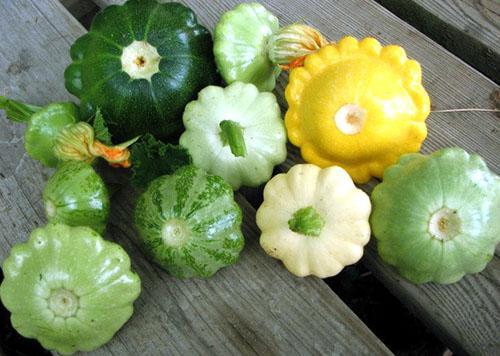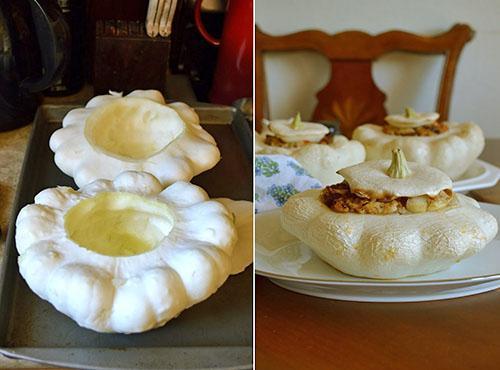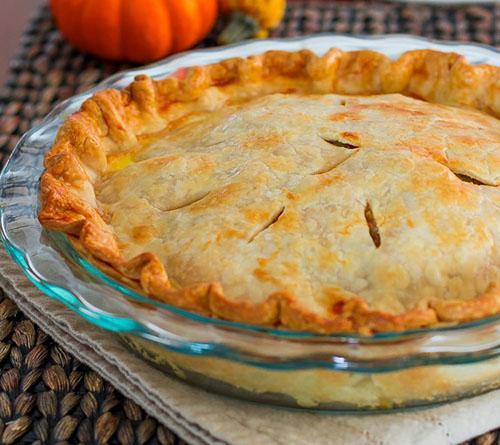Cultivation and storage of squash
 This variety of common pumpkin in various parts of the world is called vegetable and dish-shaped, in the international classification, where squash is called Cucurbita pepo var. Clypeata, its comparison with the scallop shell is fixed. The squash has a completely unusual name - the Jerusalem artichoke. The word “squash” itself comes from the name of the French closed pie, pate. It is to this dish that the vegetable culture is very similar in shape and appearance, unusual for the pumpkin family.
This variety of common pumpkin in various parts of the world is called vegetable and dish-shaped, in the international classification, where squash is called Cucurbita pepo var. Clypeata, its comparison with the scallop shell is fixed. The squash has a completely unusual name - the Jerusalem artichoke. The word “squash” itself comes from the name of the French closed pie, pate. It is to this dish that the vegetable culture is very similar in shape and appearance, unusual for the pumpkin family.

Unlike pumpkin, squash does not give lashes. They grow, like their closest relatives, zucchini, forming a large bush, on which, after flowering, a flattened, disc-shaped ovary with an almost even or curly edge appears.
It is interesting that wild-growing squash does not occur in nature. Therefore, the origin of the species is still not entirely clear. Most likely, the squash was the result of spontaneous crossing and first appeared somewhere in Central or South America, and then spread to other parts of the world. The most popular culture is in France and the United States. Moreover, on the North American continent, pattyson is deservedly called patty pan, which literally translates as a cake mold.
 In Russia, the once-famous vegetable is today forgotten and supplanted by other related species, although the cultivation of squash and caring for them will not be difficult even for a novice gardener.
In Russia, the once-famous vegetable is today forgotten and supplanted by other related species, although the cultivation of squash and caring for them will not be difficult even for a novice gardener.
Growing squash and planting care
 The seeds of the squash outwardly have a lot in common with the seeds of zucchini, they also remain viable up to 8 years, but a little narrower and smaller. The temperature at which the seeds start to grow is 12-14 ° C, and the squash develops and bears fruit at 15-27 ° C. When planting this culture, it is important to take into account that frosts are destructive for plants, therefore, seeds or seedlings of squash do not fall into open ground until the second half of May.
The seeds of the squash outwardly have a lot in common with the seeds of zucchini, they also remain viable up to 8 years, but a little narrower and smaller. The temperature at which the seeds start to grow is 12-14 ° C, and the squash develops and bears fruit at 15-27 ° C. When planting this culture, it is important to take into account that frosts are destructive for plants, therefore, seeds or seedlings of squash do not fall into open ground until the second half of May.
The dish pumpkin has its own requirements for the composition and structure of the soil. The best place to plant squash is a well-lit area with loose soil rich in organic matter. The plant feels good on black soil mixed with sawdust or sand:
- Loams fertilized with organic matter at the rate of 4–6 kg per square meter are suitable for growing squash.
- In autumn, 46 grams of superphosphate and 12 grams of potassium salts are introduced into the soil for each square meter of beds.
- In the spring, when fertilizing the soil, 13 grams are per meter urea.
When choosing a place for sowing squash, take into account that after cucumbers, zucchini, squash and pumpkins themselves, this culture should not be planted.
 How do squash grow in the vicinity of other garden crops? To avoid the development of diseases inherent in these closely related species, the squash can occupy the previous bed only after 4-5 years. But after the legumes, carrots and parsley, onions and cabbage, the harvest of these unusual pumpkins will be good, and the bushes will be healthy. As in the case of pumpkins, which go well with potatoes, squash can be grown in aisles among potato bushes. It is interesting to watch how squash grows on compost heaps. Constant heating of the soil and its nutritional value have a positive effect on the growth of the bush and the number of ovaries.
How do squash grow in the vicinity of other garden crops? To avoid the development of diseases inherent in these closely related species, the squash can occupy the previous bed only after 4-5 years. But after the legumes, carrots and parsley, onions and cabbage, the harvest of these unusual pumpkins will be good, and the bushes will be healthy. As in the case of pumpkins, which go well with potatoes, squash can be grown in aisles among potato bushes. It is interesting to watch how squash grows on compost heaps. Constant heating of the soil and its nutritional value have a positive effect on the growth of the bush and the number of ovaries.
 In open ground, seeds are planted in the second half of May.There should be 2-3 seeds per hole with a depth of 3 to 5 cm. The garden bed is marked out so that there is at least 70 cm between the plants. When the seedlings will open the first true leaves. They are thinned out, leaving one sprout per well.
In open ground, seeds are planted in the second half of May.There should be 2-3 seeds per hole with a depth of 3 to 5 cm. The garden bed is marked out so that there is at least 70 cm between the plants. When the seedlings will open the first true leaves. They are thinned out, leaving one sprout per well.
If spring cold snaps or frosts are not excluded, when growing squash, the crops must be covered with a film.
When squash is grown through seedlings, sowing in pots with a diameter of 8 cm is carried out in the last third of April. The seedlings are transferred to the ground after 25–35 days, when the danger of frost has passed. Under the film, squash can be transplanted two weeks earlier. Thanks to the powerful root system, the squash bush receives nutrition from a depth of up to half a meter and an area of soil with a diameter of about 4 meters. Therefore, infrequent but abundant plants are preferred. watering, combined with dressings:
- Seedlings with two open leaves are fed with a solution of 15–20 grams of urea and half the amount of potash and phosphorus fertilizers per square meter.
- At the stage of bud formation, feeding is repeated, doubling the rate of potassium salts and one and a half times of phosphorus and nitrogen-containing fertilizers.
- During mass fruiting, squash bushes are fertilized with a similar composition.
In dry periods, squash is watered at least 1 time per week.
 For better lighting and airing of plantings on adult fruit-bearing bushes, part of the foliage is cut off, which will prevent putrefactive bacteria and fungi from developing. In order to avoid decay of the fruit, it is better not to allow the ovary to hit the ground, and also to remove the corollas of faded flowers.
For better lighting and airing of plantings on adult fruit-bearing bushes, part of the foliage is cut off, which will prevent putrefactive bacteria and fungi from developing. In order to avoid decay of the fruit, it is better not to allow the ovary to hit the ground, and also to remove the corollas of faded flowers.
How to save squash for the winter and use in the summer?
 Like zucchini, squash is consumed unripe, when the skin has not yet hardened, the seeds have not formed, and the pulp has a rather pleasant consistency. When the pumpkin ripens, the surface layer becomes inedible, the inner part of the fruit becomes friable, and the seeds ripen. It will not be difficult to save such squash for the winter, but their nutritional value is low.
Like zucchini, squash is consumed unripe, when the skin has not yet hardened, the seeds have not formed, and the pulp has a rather pleasant consistency. When the pumpkin ripens, the surface layer becomes inedible, the inner part of the fruit becomes friable, and the seeds ripen. It will not be difficult to save such squash for the winter, but their nutritional value is low.
 It is a little more difficult to save and prepare for future use gourmet squash with a diameter of 5 to 12 cm, suitable for frying, stewing, stuffing and canning. Harvesting of such fruits is carried out at least twice a week, be sure to leave the peduncle on the squash.
It is a little more difficult to save and prepare for future use gourmet squash with a diameter of 5 to 12 cm, suitable for frying, stewing, stuffing and canning. Harvesting of such fruits is carried out at least twice a week, be sure to leave the peduncle on the squash.
The more regularly the cutting is carried out, the more new ovary is formed until the very cold.
It is almost impossible to keep young squash fresh for more than a month. At home, at a temperature of no more than 4–8 ° C, the fruits retain their appearance and taste for the longest time. Squash with dense skin are perfectly stored until spring. At the same time, the fruits sent to the storage must be intact, without scratches and dents on the skin, with a small stalk and the remnants of a flower removed.
The best storage conditions are 1-3 ° C, moderate humidity and ventilation.
How to keep the squash for the winter indoors? To do this, the fruits are wrapped in paper and placed in a dark place so that the pumpkins do not touch. Like zucchini, squash, taken long before maturity, can be great ingredients for homemade marinades, pickles and delicious vegetable caviar.
How to keep the squash practically fresh and juicy for the winter? Young squash can be kept fresh by quick-freezing in the form of whole small fruits intended for stuffing, or small cubes for stews, soups and other culinary dishes. Frozen vegetables fully retain the nutritional value and taste of freshly picked fruits.